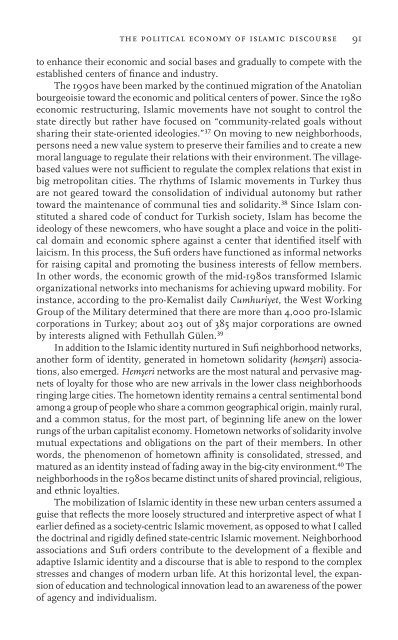You also want an ePaper? Increase the reach of your titles
YUMPU automatically turns print PDFs into web optimized ePapers that Google loves.
the political economy of islamic discourse 91to enhance their economic and social bases and gradually to compete with theestablished centers of Wnance and <strong>in</strong>dustry.The 1990s have been marked by the cont<strong>in</strong>ued migration of the Anatolianbourgeoisie toward the economic and political centers of power. S<strong>in</strong>ce the 1980economic restructur<strong>in</strong>g, <strong>Islamic</strong> movements have not sought to control thestate directly but rather have focused on “community-related goals withoutshar<strong>in</strong>g their state-oriented ideologies.” 37 On mov<strong>in</strong>g to new neighborhoods,persons need a new value system to preserve their families and to create a newmoral language to regulate their relations with their environment. The villagebasedvalues were not suYcient to regulate the complex relations that exist <strong>in</strong>big metropolitan cities. The rhythms of <strong>Islamic</strong> movements <strong>in</strong> <strong>Turkey</strong> thusare not geared toward the consolidation of <strong>in</strong>dividual autonomy but rathertoward the ma<strong>in</strong>tenance of communal ties and solidarity. 38 S<strong>in</strong>ce Islam constituteda shared code of conduct for Turkish society, Islam has become theideology of these newcomers, who have sought a place and voice <strong>in</strong> the politicaldoma<strong>in</strong> and economic sphere aga<strong>in</strong>st a center that identiWed itself withlaicism. In this process, the SuW orders have functioned as <strong>in</strong>formal networksfor rais<strong>in</strong>g capital and promot<strong>in</strong>g the bus<strong>in</strong>ess <strong>in</strong>terests of fellow members.In other words, the economic growth of the mid-1980s transformed <strong>Islamic</strong>organizational networks <strong>in</strong>to mechanisms for achiev<strong>in</strong>g upward mobility. For<strong>in</strong>stance, accord<strong>in</strong>g to the pro-Kemalist daily Cumhuriyet, the West Work<strong>in</strong>gGroup of the Military determ<strong>in</strong>ed that there are more than 4,000 pro-<strong>Islamic</strong>corporations <strong>in</strong> <strong>Turkey</strong>; about 203 out of 385 major corporations are ownedby <strong>in</strong>terests aligned with Fethullah Gülen. 39In addition to the <strong>Islamic</strong> identity nurtured <strong>in</strong> SuW neighborhood networks,another form of identity, generated <strong>in</strong> hometown solidarity (hem7eri) associations,also emerged. Hem7eri networks are the most natural and pervasive magnetsof loyalty for those who are new arrivals <strong>in</strong> the lower class neighborhoodsr<strong>in</strong>g<strong>in</strong>g large cities. The hometown identity rema<strong>in</strong>s a central sentimental bondamong a group of people who share a common geographical orig<strong>in</strong>, ma<strong>in</strong>ly rural,and a common status, for the most part, of beg<strong>in</strong>n<strong>in</strong>g life anew on the lowerrungs of the urban capitalist economy. Hometown networks of solidarity <strong>in</strong>volvemutual expectations and obligations on the part of their members. In otherwords, the phenomenon of hometown aYnity is consolidated, stressed, andmatured as an identity <strong>in</strong>stead of fad<strong>in</strong>g away <strong>in</strong> the big-city environment. 40 Theneighborhoods <strong>in</strong> the 1980s became dist<strong>in</strong>ct units of shared prov<strong>in</strong>cial, religious,and ethnic loyalties.The mobilization of <strong>Islamic</strong> identity <strong>in</strong> these new urban centers assumed aguise that reXects the more loosely structured and <strong>in</strong>terpretive aspect of what Iearlier deWned as a society-centric <strong>Islamic</strong> movement, as opposed to what I calledthe doctr<strong>in</strong>al and rigidly deWned state-centric <strong>Islamic</strong> movement. Neighborhoodassociations and SuW orders contribute to the development of a Xexible andadaptive <strong>Islamic</strong> identity and a discourse that is able to respond to the complexstresses and changes of modern urban life. At this horizontal level, the expansionof education and technological <strong>in</strong>novation lead to an awareness of the powerof agency and <strong>in</strong>dividualism.




